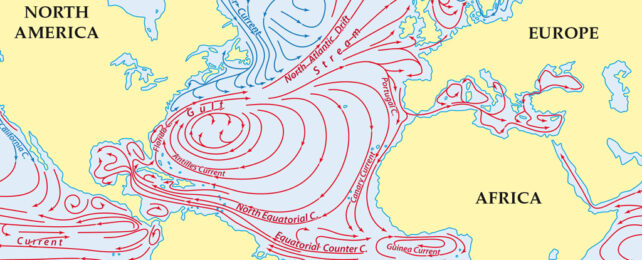A major ocean current system in the Atlantic could be about to collapse as soon as 2025, concerning new peer-reviewed research suggests.
This is particularly concerning in light of the current heat extremes we're witnessing across the globe, including a massive departure from previous records in the Atlantic Ocean itself.
"Here we calculate when the early warning signs are significantly above the natural variations," write physicist Peter Ditlevsen and statistician Susanne Ditlevsen from the University of Copenhagen.
"Given the importance of the AMOC for the climate system, we ought not to ignore such clear indicators of an imminent collapse."
The Atlantic Meridional Overturning Circulation (AMOC) is a large system of ocean currents that regulates the transfer of ocean heat from the tropics to the northern hemisphere.
As such, it impacts much of Earth's climate. It is considered one of the most important tipping elements in Earth's climate system, and has been slowing down since the mid-1900s.
If it stalls completely, monsoon seasons will likely be disrupted in the tropics, and Europe and North America will experience dangerously harsher winters. The knock-on effects will severely impact entire ecosystems and our food security.
The AMOC has only been directly monitored since 2004, which is not long enough to understand the full trajectory of its current slowing trend.
So by examining many models, the researchers identified an ocean area where sea surface temperatures most strongly match the ocean's circulation condition, to use as one of two less direct indicators for which records exist as far back as 1870.
The other early warning sign the researchers considered is "loss of resilience" in the system, which presents as increased fluctuations and variance – like the increasing wobble of a spinning top before it topples over.
Using these two early warning signs to assess AMOC's condition is somewhat like measuring pulse and blood pressure to monitor heart health.
The team's modeling suggests that this all important ocean circulation could stall as early as 2025, and likely no later than 2095.
These findings are alarmingly sooner than the most recent IPCC predictions, but the early warning signs are already clear, Peter Ditlevsen and Susanne Ditlevsen argue.
Previous models have "biases toward overestimated stability of the AMOC, both from tuning to the historic climate record, poor representation of the deep water formation, salinity and glacial runoff," the team points out in the paper.
What's more, the speed at which we hit this destabilizing event could also determine if the system collapses or re-steadies.
As we have not only failed to decrease the amount of greenhouse gasses we've been pumping into the atmosphere so far – but increased them instead – it sure looks like we're on a frightening trajectory to hit this ocean threshold mighty hard and fast.
Past research has suggested that previous extreme climate fluctuations or Dansgaard-Oeschger events were caused by such instability.
Previous research has also shown that changing just one parameter, such as increasing the amount of freshwater entering the North Atlantic, can cause the system to bifurcate – lead to a sudden and drastic change in the system's behavior.
This level of sensitivity may not have been maintained in the IPCC's assessment, as not all the models they've included take it into consideration.
We still do not understand all the factors that might impact this system, and other researchers have argued elements such as the impact of cold water influx do not fully match past climate records.
The researchers think their method focusing on the early warning symptoms avoids the need to fully understand these drivers, but caution they can't rule out some unknown unknowns creating a different outcome. They also can't distinguish between a partial or full collapse of the AMOC, they explain.
"Even with these reservations, this is indeed a worrisome result, which should call for fast and effective measures to reduce global greenhouse gas emissions in order to avoid the steady change of the control parameter toward the collapse of the AMOC," the team concludes.
This research was published in Nature Communications.
